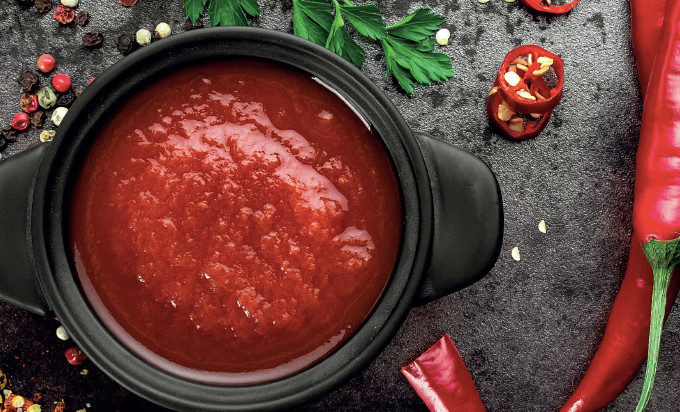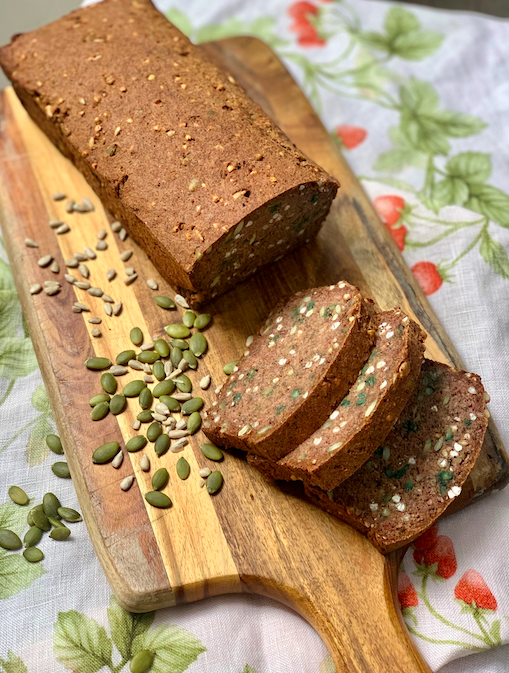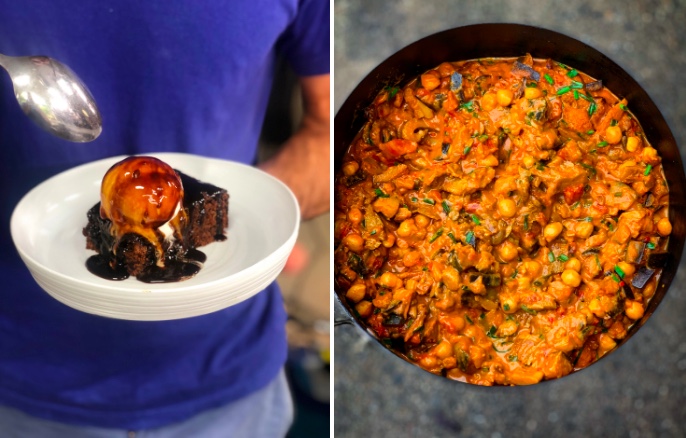In our Autumn 2020 issue, Elle Fox of CNM (The College of Naturopathic Medicine) wrote about the drawbacks of gluten, while Svetlana Sidorova provided us with a great gluten-free recipe for Buckwheat and Almond Meal Bread. We can’t wait to try it out!
Recipe
We always look forward to The Happy Pear’s delicious recipe offerings in each magazine … and our Autumn 2020 issue was no exception! In this issue, they gave us two gorgeous recipes: one for an Aloo Gobi Indian potato and cauliflower curry, and one for an epic vegan cheesecake. Read on for all the details!
Today, we are excited to share not one, but TWO amazing recipes by The Happy Pear: a savoury delight and a sweet treat. These recipes appear in our Autumn 2019 issue. Check them out below!
We were delighted to welcome The Happy Pear twins, David and Stephen Flynn, to the Positive Life fold in our Spring 2019 issue! They shared a gorgeous pizza recipe that will be perfect for the coming days and weeks, when the heat gradually returns and we feel more inclined to embark on spring picnics. Enjoy!
If you’re stuck for ideas about what to cook for the vegan in your life this Christmas, this recipe for banana blossom ‘fishless’ cake with tartar sauce could be a perfect fit! It is brought to you by the amazing Tony Keogh, head chef of the popular Cornucopia restaurant. Read on to learn more. This recipe appears in our Winter 2018/19 issue – click here to find your local stockist, or here to subscribe to the magazine.
In our Autumn 2018 issue, Cornucopia head chef Tony Keogh shared a delicious recipe for a white chocolate and berry tart. Sounds scrumptious, doesn’t it? Read on to learn how you can recreate this beauty in your own kitchen.

Autumnal Indulgence
Let your senses feast on this delicious dessert
by Tony Keogh
This tart is very simple to put together and is a real crowd pleaser. There is something about the combination of white chocolate and berries that sings a beautiful song. In this recipe, that combination is used to full effect: the chocolate cuts smoothly like a knife through the tartness of fresh seasonal berries. The chocolate and berries are then offset with a rich nutty base, which is enhanced with the delicate flavour of apricot.
White chocolate and vanilla tart in an apricot brazil nut crust with macerated autumn berries
For the base
140 grams desiccated coconut
100 grams brazil nuts
100 grams flaked almond
220 grams ready to eat apricots
For the filling
120 grams cacao butter
120 grams coconut oil
120 grams cashew nuts
120 grams non-refined caster sugar
350 ml water
3 tsp of agar powder
Vanilla extract
Pinch of salt
100 ml soy milk
For the fruit
150 grams autumn berries
Zest of one lime
Dessertspoon of non-refined sugar
Method
1. Start with the base. In a food processor, mill the brazil nuts, almonds and coconut, adding the apricots slowly, until the mixture comes together. Line a 28 cm tart tin with the mixture and bake it for about 8 minutes. While it is baking, prepare the filling.
2. Bring the water to a simmer and place a metal bowl over it. Add the cacao butter. When it melts, add the coconut oil. When both have melted together, remove the bowl, add the sugar to the water and bring it back to a simmer. Add the agar, boil the mixture for a minute or two, then remove it from the heat.
3. Add the cashews, soya milk and the water mixture to a blender and blend until smooth. Whisk this mixture into the melted fats. Add some vanilla, a pinch of salt and taste for sweetness. If you are happy, pour the mixture in and leave it aside somewhere cool to set.
4. For the macerated fruit, simply combine all the ingredients and set them aside for at least half an hour. Serve the tart with a good dollop of fruit.
This article – explaining the ins and outs of chilli and chilli culture – was brought to you by our resident gardening expert, Hans Wieland in our Spring 2018 issue. He also provided us with a delicious chilli sauce recipe. Here, we share the article in its entirety. Read it and learn how to bring a touch of inspiration into your kitchen!

The Cult of Chillies: Growing vegetables that make a difference
By Hans Wieland
Chilli Peppers, Bell Peppers, Hot Peppers, Sweet Peppers, Cayenne Peppers, Spanish Peppers, Red Hot Chili Peppers, what have they all in common? Confused?
Ok, the last “variety” the Red Hot Chili Peppers, a funk-rock band from Los Angeles is only around since 1983, and all the others have nothing in common with black pepper (Piper nigrum), but are in fact all species of the genus Capsicum. Commonly we distinguish between the sweet and mild peppers and the hot and more pungent chillies, the topic of our article. Most of our common chillies come from one species, Capsicum annum, which was first cultivated in Mexico at least 5000 years ago.
The cult story of chillies begins with Columbus, who thought he found the (black) pepper and continues with the colonial trading power of the Portuguese bringing the chilli everywhere, leading to India becoming the biggest producer. The Aztec word of the native Nahuatl was chilli, which means red. Botanically speaking all peppers are fruits; however, they are correctly considered vegetables in a culinary context. The success story of the chilli is remarkable as the world production and consumption is now 20 times that of black pepper, the other major pungent spice (On Food and Cooking, p 418).
Hungary has its Paprika, Spain its Pimenton, Italy its Peperoni and in China chilli is a major spice in Sichuan and Hunan, but Mexico remains the most advanced country when it comes to chilli culture, it being a major ingredient in Salsas. At Neantog Kitchen Garden School we grow it mainly to produce our own sauces (see recipe below). The beauty of growing it yourself is in the choice of varieties, from mild to super-hot.
What makes Chillies so special?
It is Capsaicin, the active chemical ingredient, contained in the placenta, the tissue that bears the seeds. The variety and the growing conditions – high temperatures and the length of the season – contribute to the amount of capsaicin produced. The heat of a chilli is measured on the Scoville Scale in Scoville heat units (SHU), or capsaicin concentration, named after its creator, US pharmacist Wilbur Scoville. SHU values range from 0 in a sweet bell pepper to 2,000,000-2,200,000 in a Trinidad Moruga Scorpion or Carolina Reaper. Naturally, there is the burning sensation in our mouth which for some is pure pleasure.
How to grow chillies
As Chillies love heat and light, it makes them an ideal crop for growing in polytunnels in Ireland. Some varieties are also suitable for pots in a conservatory. Two or three plants yield more than enough for a family for a year. Chilli peppers require a long growing season and are best sown from early February until mid-March at the latest. I sow them in modules on a heat propagator at 20 degrees Celsius. Once they have germinated I transfer them to 7cm wide pots using potting compost. Three or four weeks later they can be potted on to 1litre pots. In early May in mild areas or in mid- to late-May in cooler areas I plant them into the polytunnel spaced 50cm apart and staked, to prevent them from falling over when the branches get heavy with fruits. Apart from regular watering, there is little else you need to do.
Chillies can be harvested throughout the summer whenever required. All chillies start off green and then turn into their final colour. Green chillies are a little less hot. Towards the end of the growing season in October I usually harvest all the remaining chillies and dry them in the kitchen. They will last for well over a year.
Here are my favourite varieties:
Jalapeno, (C. annuum), a classic from Mexico, with bullet shaped fruits, green to red and medium hot (2500 – 8000 SHU)
Ring of Fire, Cayenne type, (C. annuum), long, thin, pointed pods, (30 000 – 50 000 SHU)
Tabasco, (C. frutescens), named after the Mexican state Tabasco and also the name of the Louisiana produced hot sauce, (30 000 – 50 000 SHU). The chilli for the fermenters to make their own variety of the famous sauce.
Habanero, (C. chinense), from Cuba, small bell shaped, yellow, orange or red, (100 000 – 350 000 SHU)
Numex Twilight (C. annuum), the best windowsill chilli I’ve grown; tiny, upright fruit that start purple and ripen to bright red, perfect for those without a garden, ( 30 000 – 50 000 SHU)
Neantog Chilli Sauce:
For 250ml you need:
6 small red chillies (we love Jalapeno, Cayenne and Ring of Fire)
5 cloves of garlic
40 grams ginger
1 stem of lemongrass
Juice of 1 lime/lemon
175 grams of brown sugar
3tsp sea salt
175ml of cider vinegar
175 ml of water
½ tsp of arrow root dissolved in 2 tbsp of water
Chop the chillies, garlic, ginger and lemongrass very finely (use gloves!), mix with the rest of the ingredients. Bring to the boil, reduce heat and let simmer for around 15 mins, then add the arrow root powder dissolved in water and bring to the boil to thicken. Fill in hot into sterile glass bottles, close and let cool.
Hans Wieland has worked and taught at The Organic Centre for over 20 years. In May he is “retiring” to Neantog Kitchen Garden School in Cliffoney, again joining his wife Gaby Wieland, herbalist and Naturopath. The couple offer a range of courses and workshops in food growing, fermenting, foraging, cheese making, healthy cooking and baking. www.neantog.com







